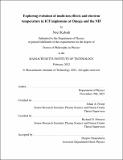Exploring evolution of multi-ion effects and electron temperature in ICF implosions at Omega and the NIF
Author(s)
Kabadi, Neel
DownloadThesis PDF (49.57Mb)
Advisor
Frenje, Johan A.
Petrasso, Richard D.
Terms of use
Metadata
Show full item recordAbstract
In inertial confinement fusion (ICF) implosions, one of the most important parameters for quantifying performance is temperature. In this thesis, effects related to temperature evolution of both the ions and electrons within the central plasma are explored in detail.
From measurements of multiple ion temperatures in shock-driven ICF implosions, it is determined that shocks couple energy directly proportional to mass in multi-ion plasmas causing the deuterons and tritons to be out of thermal equilibrium during the shock-burn phase. It is also found that separation of the ion species can be explained by multi-ion diffusion that is driven by the strong gradients in the converging shock front.
Measurement of the hotspot electron temperature is not affected significantly by the converging shock and plasma flows like the ion temperature. In this thesis, the design and prototype testing of a new diagnostic for measurements of time-resolved hotspot electron temperature in ignition-relevant implosions at the OMEGA laser facility is discussed. Initial data obtained in OMEGA Cryo-DT and room-temperature implosion experiments are discussed. A finalized diagnostic design and implementation plan is also presented.
An ICF implosion is an ideal platform for studying energy-dependent fusion cross sections, relevant to stellar nucleosynthesis, as the ions are fully ionized within a thermal plasma, nicely mimicking the conditions in stellar objects. The D3He fusion cross section was studied in this work through measurements of the DD and D3He fusion yields. It was found that the ICF-based measurements resulted in a significantly lower cross section than obtained in standard accelerator-based experiments. This finding has implications for modeling of bound-electron screening in accelerator experiments, and for modeling of reaction rates is stellar objects.
Date issued
2022-02Department
Massachusetts Institute of Technology. Department of PhysicsPublisher
Massachusetts Institute of Technology